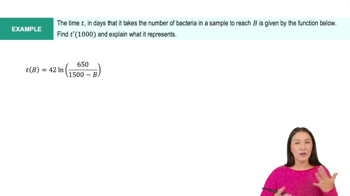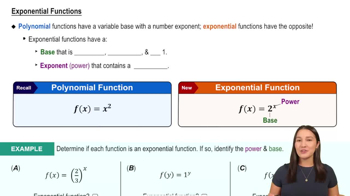Table of contents
- 0. Functions7h 52m
- Introduction to Functions16m
- Piecewise Functions10m
- Properties of Functions9m
- Common Functions1h 8m
- Transformations5m
- Combining Functions27m
- Exponent rules32m
- Exponential Functions28m
- Logarithmic Functions24m
- Properties of Logarithms34m
- Exponential & Logarithmic Equations35m
- Introduction to Trigonometric Functions38m
- Graphs of Trigonometric Functions44m
- Trigonometric Identities47m
- Inverse Trigonometric Functions48m
- 1. Limits and Continuity2h 2m
- 2. Intro to Derivatives1h 33m
- 3. Techniques of Differentiation3h 18m
- 4. Applications of Derivatives2h 38m
- 5. Graphical Applications of Derivatives6h 2m
- 6. Derivatives of Inverse, Exponential, & Logarithmic Functions2h 37m
- 7. Antiderivatives & Indefinite Integrals1h 26m
- 8. Definite Integrals4h 44m
- 9. Graphical Applications of Integrals2h 27m
- 10. Physics Applications of Integrals 2h 22m
3. Techniques of Differentiation
The Chain Rule
Problem 82
Textbook Question
{Use of Tech} Cell population The population of a culture of cells after t days is approximated by the function P(t)=1600 / 1 + 7e^−0.02t, for t≥0.
a. Graph the population function.
 Verified step by step guidance
Verified step by step guidance1
Step 1: Understand the function P(t) = \frac{1600}{1 + 7e^{-0.02t}}. This is a logistic function, which is commonly used to model population growth where the growth rate decreases as the population reaches a carrying capacity.
Step 2: Identify key features of the logistic function. The carrying capacity, or the maximum population, is 1600. The initial population can be found by evaluating P(0).
Step 3: Determine the horizontal asymptotes. As t approaches infinity, the term 7e^{-0.02t} approaches zero, so the function approaches the carrying capacity of 1600. As t approaches negative infinity, the function approaches zero.
Step 4: Calculate a few key points to help sketch the graph. Evaluate P(t) at t = 0, t = 10, t = 20, etc., to see how the population changes over time.
Step 5: Use a graphing tool or software to plot the function P(t) = \frac{1600}{1 + 7e^{-0.02t}}. Observe the S-shaped curve typical of logistic growth, starting near zero, increasing rapidly, and then leveling off near the carrying capacity.
 Verified video answer for a similar problem:
Verified video answer for a similar problem:This video solution was recommended by our tutors as helpful for the problem above
Video duration:
5mPlay a video:
Was this helpful?
Key Concepts
Here are the essential concepts you must grasp in order to answer the question correctly.
Logistic Growth Model
The function P(t) = 1600 / (1 + 7e^(-0.02t)) represents a logistic growth model, which describes how populations grow in a limited environment. Initially, the population grows exponentially, but as resources become limited, the growth rate slows and approaches a maximum carrying capacity, in this case, 1600 cells.
Recommended video:

Derivative of the Natural Logarithmic Function Example 7
Exponential Function
The term e^(-0.02t) in the population function indicates an exponential decay factor, which influences how quickly the population approaches its carrying capacity. Exponential functions are characterized by their rapid growth or decay, and in this context, they help model the initial growth phase of the cell population before it stabilizes.
Recommended video:

Exponential Functions
Graphing Functions
Graphing the population function involves plotting the values of P(t) against t to visualize how the cell population changes over time. Understanding how to graph functions is essential in calculus, as it allows for the analysis of behavior, trends, and key features such as intercepts, asymptotes, and limits.
Recommended video:

Graph of Sine and Cosine Function

 5:02m
5:02mWatch next
Master Intro to the Chain Rule with a bite sized video explanation from Callie
Start learningRelated Videos
Related Practice







